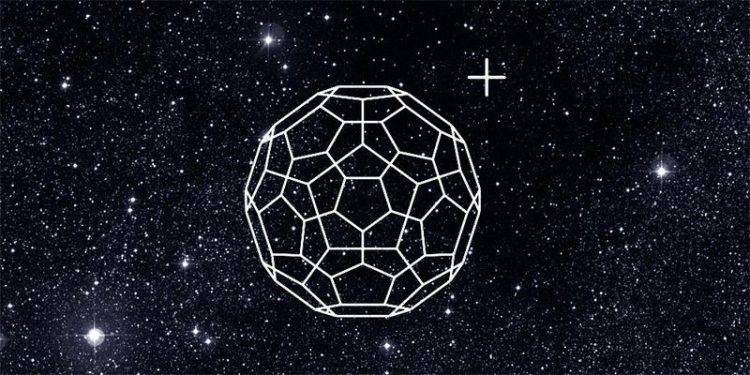Old Astronomic Riddle on the Way to Be Solved

Ionized Buckminsterfullerene (C60+) is present at the gas-phase in space. University of Basel
Almost 100 years ago, astronomers discovered that the spectrum of star light arrived on earth with dark gaps, so-called interstellar bands. Ever since, researchers have been trying to find out which type of matter in space absorbs the light and is responsible for these “diffuse interstellar bands” (DIB) of which over 400 are known today.
Football molecule and interstellar clouds
Astronomers have been suspecting for a while that big complex molecules and gaseous ions based on carbon could be absorbing the starlight. The Buckminsterfullerene is such a molecule: a structure made up of 60 carbon atoms shaped like a football that was first discovered in the mid-1980s.
After this discovery, the questions arose if it was possible that the football molecule was in fact responsible for the DIB. The research team led by Prof. John P. Maier from the Department of Chemistry at the University of Basel has been studying the electronic absorption of the ionized Buckminsterfullerene since 1993. In fact, the spectrum measured in the lab did show absorption features at two wavelengths that were near two DIB that had been discovered by astronomers the following year.
Conditions similar to outer space
In order to unequivocally prove that these molecules absorb starlight and thus produce the DIB, a gas phase spectrum of the ion was needed. The Basel researchers now succeeded at this: “This is the very first unequivocal identification of such a molecule in the interstellar clouds”, says Professor John P. Maier. “We have achieved a breakthrough in solving the old riddle of the diffuse interstellar bands.”
In order to obtain the spectrum in the laboratory using a diode laser, several thousand ionized Fullerenes were confined in a radiofrequency trap and cooled down by collisions with high density helium to very low temperatures of around 6 degree Kelvin – conditions very similar to outer space.
The absorptions measured in the laboratory coincide exactly with the astronomical data, and have comparable bandwidths and relative intensities. This identifies for the first time two DIB and proves that ionized Buckminsterfullerene (C60+) is present at the gas-phase in space. “This is remarkable, considering the complexity of this molecular ion and the presence of high-energy radiation in such an environment”, says Maier.
Original source
E. K. Campbell, M. Holz, D. Gerlich & J. P. Maier
Laboratory confirmation of C60+ as carrier of two diffuse interstellar bands
Nature (2015), doi: 10.1038/nature14566
Further information
Professor John P. Maier, University of Basel, Department of Chemistry, phone: +41 61 267 38 26, email: j.p.maier@unibas.ch
Media Contact
More Information:
http://www.unibas.chAll latest news from the category: Life Sciences and Chemistry
Articles and reports from the Life Sciences and chemistry area deal with applied and basic research into modern biology, chemistry and human medicine.
Valuable information can be found on a range of life sciences fields including bacteriology, biochemistry, bionics, bioinformatics, biophysics, biotechnology, genetics, geobotany, human biology, marine biology, microbiology, molecular biology, cellular biology, zoology, bioinorganic chemistry, microchemistry and environmental chemistry.
Newest articles

Webb captures top of iconic horsehead nebula in unprecedented detail
NASA’s James Webb Space Telescope has captured the sharpest infrared images to date of a zoomed-in portion of one of the most distinctive objects in our skies, the Horsehead Nebula….

Cost-effective, high-capacity, and cyclable lithium-ion battery cathodes
Charge-recharge cycling of lithium-superrich iron oxide, a cost-effective and high-capacity cathode for new-generation lithium-ion batteries, can be greatly improved by doping with readily available mineral elements. The energy capacity and…

Novel genetic plant regeneration approach
…without the application of phytohormones. Researchers develop a novel plant regeneration approach by modulating the expression of genes that control plant cell differentiation. For ages now, plants have been the…





















